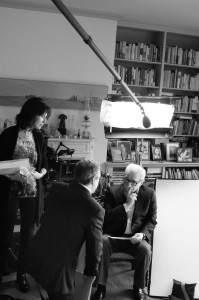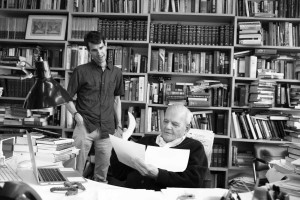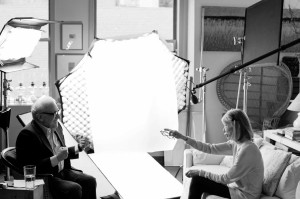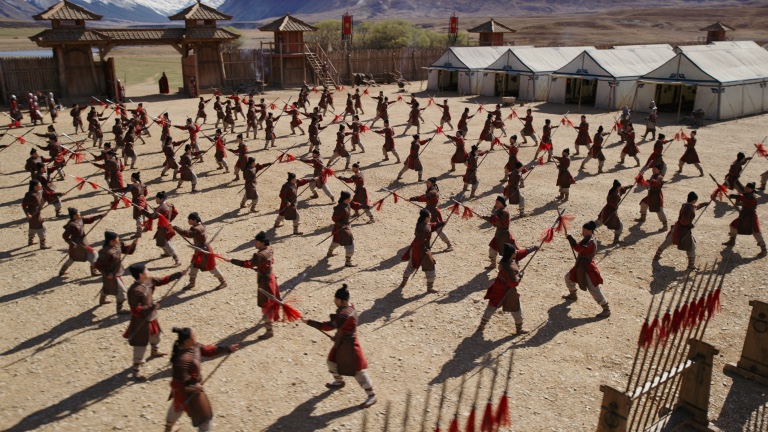
With Martin Scorsese as co-director, David Tedeschi embarked on an ambitious project, the HBO documentary The 50-Year Argument, concerning the 50th anniversary of the prestigious periodical, The New York Review of Books.
“We’ve worked together a lot before,” Tedeschi explained. “I was a film editor on Shine a Light and No Direction Home. But this project was different. He was working on Wolf of Wall Street. There was a certain amount of time pressure. He wasn’t sure how much time he would really have, so he invited me in to a different kind of collaboration.”
Coming onboard as co-director of the project, Tedeschi had never been involved in the production side of filmmaking before. “I did about half of the interviews,” he explained. “There were others where Marty did the interview. There’s a bunch of interviews on the very first night. We went into that together. It’s a like a common goal that you work towards. That’s what it felt like.”
With over a year of work on the project, Tedeschi brought in editors Paul Marchand and Michael Palmer to cut the film. “I didn’t want to take on too much,” Tedeschi explained. “I thought it would be good to not worry about the details in editorial, though I did work on a lot of those details. Mike Palmer was my assistant on Living in the Material World. He added a lot to the process. Paul came in for 12 weeks to help us. As a film editor, it was interesting to see the process.”

To execute Scorsese and Tedeschi’s combined visions, production acquired ample footage. “We shot at The Review for a while, verité style,” Tedeschi stated. “We had in the range of 40 interviews. We interviewed [head of The New York Review] Bob Silvers at least three times. One was three-four hours.”
As soon as Scorsese and Tedeschi started shooting and their archival research proceeded, a critical mass of approximately 15 staffers worked on the project. “It turned out to have a certain chronological feel,” Tedeschi explained of covering the magazine’s 50 years.
Personally, Tedeschi had only a tangential connection to The New York Review of Books. “I opened it up in my high school years. My mom had a subscription,” he said. “I had never read anything from the 1960s and early 1970s. Everything is online — they are forward thinking — if you get a subscription, you can get access to the entire archives.”
In doing the research, Tedeschi immersed himself in all issues of the magazine from its first decade of 1963-1973, obviously a volatile period of American history. “It is a fascinating document of the time, from the very first issue with the piece on James Baldwin and a piece by Susan Sontag,” he said. “The first time we really started to find our voice was when we found the footage of Mary McCarthy. I think she’s an interesting writer. I had read her stuff on Vietnam. I didn’t want to say I was a fan. I had read all of her non-fiction. It was as if her archival material was scripted. We found that piece where she said, ‘This is a terrible thing that’s going on’ about the Vietnam War.”

As with such revelations, Tedeschi discovered a newfound fondness for directing via his work on the project. “It’s one of the interesting things working with Marty,” he revealed. “He has a great instinct for mining great material. I wouldn’t have known that all of this could be so scintillating.”
As such, during production, Tedeschi began to comprehend the importance of his subject. “I think that Bob Silvers says it very clearly,” Tedeschi said. “They wanted to question establishments. Aside from a very strong belief in human rights, I don’t know that they have a liberal bias. I asked John Gray who is not in the film, but who is considered right of center. He said that he never had a problem with The Review: ‘They always seem to want to publish what I have to say.’ It’s an evolution. What The Review was in the 1960s is not what The Review is today. I think the worlds are so different. Each wave of history brings its own challenges.”
For a first time director, one of the major uncertainties can be the level at which one feels he or she has accumulated enough material, and the same held true for Tedeschi on The 50 Year Argument. “At one point, Marty kept saying that we need more,” he said. “We weren’t giving The Review its due. They’ve published over 15,000 articles. We had the Yasmine El Rashidi section in the beginning. Her coverage of the weeks when the military took power in Cairo was so different from everywhere else in the West. Bob trusted her. As we were looking at the film, we felt like it was missing a certain kind of specificity in terms of that point of view. The film wasn’t going far enough; that was Marty’s impulse. We added the second section where she says what it would take for Egypt to develop a democratic society. Her mind was so imaginative.”

Elsewhere, Joan Didion offered the filmmakers additionally provocative material, especially the late 1980s during the mock trial held by New York media regarding the attack on the Central Park jogger and the five boys initially accused, later exonerated. “I lived in New York in that period,” said Tedeschi. “There was the whole media [circus] – your world was defined by newspapers, TV and radio. You fast forward to this piece. It was wonderful and shocking to me. Joan Didion was able to see the lie when nobody else in the mainstream press saw it. She takes on everybody: the tabloids, TV, the establishment press, the African-American press. She feels like they are all getting it wrong. Bob says this is what we want writers to do: to bring accuracy and an understanding. Didion had worked for The Wall Street Journal. She goes on to say that when she wrote this coverage, Bob would call her up: ‘The New York Times headline is completely different from what you are writing.’ It’s emblematic from how forward thinking they are. Her material was so controversial.”
In the film, Tedeschi and Scorsese attempt to establish how The New York Review distinguished itself from New York’s daily papers. ”They want longer analysis, longer articles, and they’re willing to do what’s necessary to do that,” said Tedeschi. “I don’t know that every writer meets every deadline. Most of it starts out as a book review. If what the person has to say is significant enough, it’s okay if it comes out later.”
In closing, when asked if The New York Review is still relevant 50 years onward, Tedeschi, without hesitation, claimed, “It’s more relevant now that ever.”





